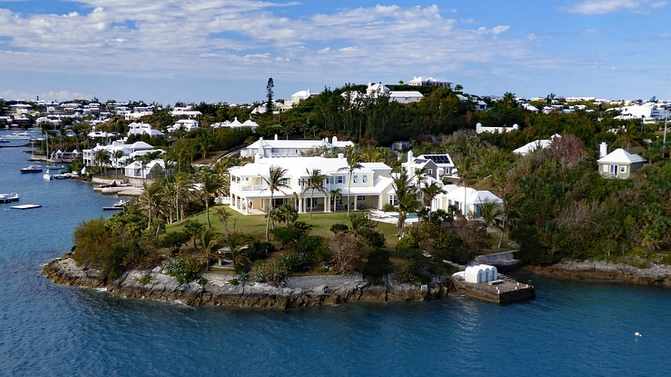If you’ve ever gone to Bermuda, you probably think of several things – its pink sand beaches, its gorgeous reefs that are prized by divers, its mixed cultures of Native American, African, and European, and, of course, those gorgeous white roofs that seem to be everywhere.
Those white roofs are for much more than just uniformity – they act as a form of water collection. Bermuda’s been doing it for centuries.
Bermuda has no freshwater springs, rivers or lakes. It’s is set on limestone, which is porous. When wells are dug, they often yield brackish or saltwater. So instead of trying to get water from the ground, Bermudans look to the sky. Rainwater.
Early settlers originally used to pave hillsides to collect rainwater. They also began designing their roofs in step-like sloped surfaces with gutter ridges. The roofs then funnel the rainwater toward pipes that lead to underground tanks that are usually in the house’s basement.
The roofs are made of limestone blocks which are sliced into individual slates. Each slate is covered in several layers of cement wash and the roof is finished with whitewash.
The white cement wash compound (it’s a paint & powder mixture) sanitizes the rainwater as it runs off into its holding tank since the white color reflects UV light from the sun (the roofs still have to be cleaned of bird droppings, leaves, etc.)
Once the roof is in operation and the tank has water in it, an electric pump lifts the water from the tank and it’s kept under a certain amount of pressure. The water is propelled by compressed air, where it exits out of open spigots anywhere in the house.
Many houses have a separate system of plumbing that leads directly to the bathrooms. For those systems, wells on the property use salt or brackish water, which is mainly used for flushing toilets. It’s estimated that flushing consumes 40 to 50% of the total water used in a typical residence every day, so these secondary wells save a significant amount of rainwater.
Modern exploration has discovered freshwater accumulations under the Island and reverse osmosis processing plants have allowed some larger hotels to supply their guests with more abundant water. However, most residents still depend on their roofs for their water. In fact, government regulations require that new homes, schools, and other buildings have at least 80% of the surface of their roofs guttered to collect the average 55” of average annual rainfall the island gets, as well as specify the size of their holding tanks (for each square foot of roof space, all houses must have eight gallons of tank space).
Those white roofs don’t just collect rainwater. Not surprisingly, they also help keep Bermudan homes cooler during the hotter months of the year. AND the heavy limestone is more difficult for hurricane-strength winds to knock over. Some homes have had the same roof for well over 200 years!
And now you know! 🙂
Feature Photo: Pixabay
Want to comment on this post? Great! Read this first to help ensure it gets approved.
Like this post? Please share it! We have plenty more just like it and would love it if you decided to hang around and get emailed notifications of when we post. Or maybe you’d like to join our Facebook group – we have 22,000+ members and we talk and ask questions about travel (including Disney parks), creative ways to earn frequent flyer miles and hotel points, how to save money on or for your trips, get access to travel articles you may not see otherwise, etc. Whether you’ve read our posts before or this is the first time you’re stopping by, we’re really glad you’re here and hope you come back to visit again!
This post first appeared on Your Mileage May Vary
Join our mailing list to receive the latest news and updates from our team.

